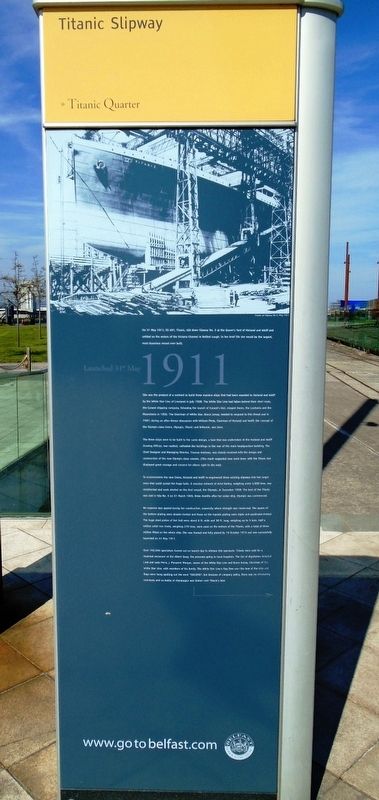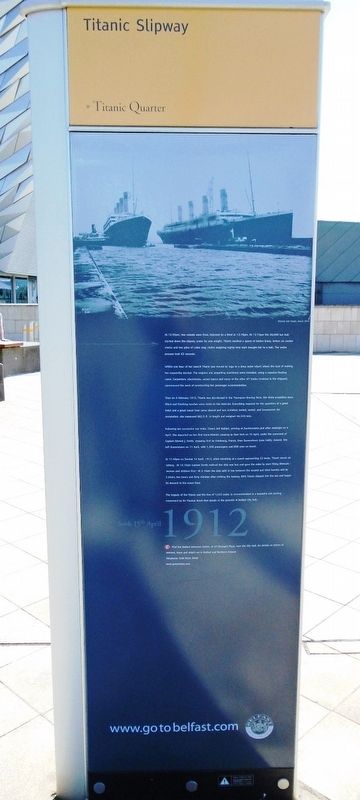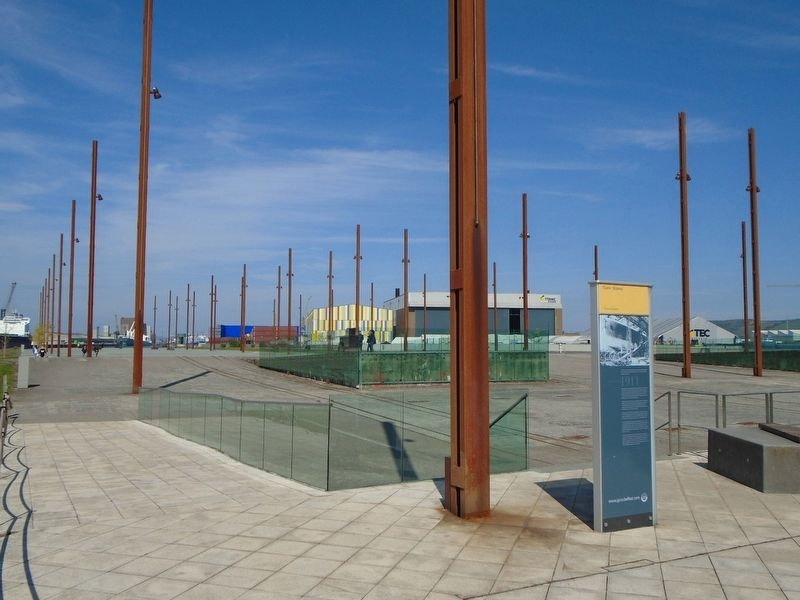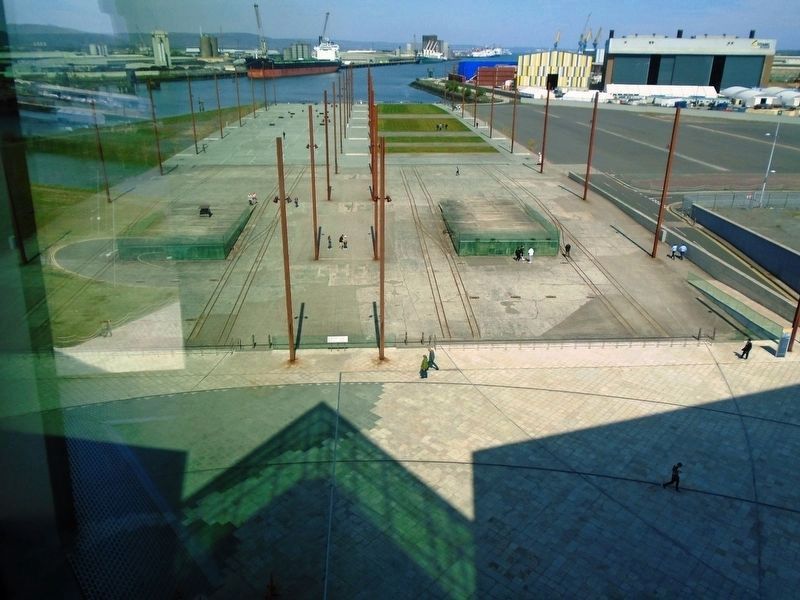Titanic Slipway
Titanic Quarter
— Launched 31st May 1911 • Sank 15th April 1912 —
[Front]
On 31 May 1911, SS 401, Titanic, slid down Slipway No. 3 at the Queen's Yard of Harland and Wolff and settled on the waters of the Victoria Channel in Belfast Lough. In her brief life she would be the largest, most luxurious vessel ever built.
She was the product of a contract to build three massive ships that had been awarded to Harland and Wolff by the White Star Line of Liverpool in July 1908. The White Star Line had fallen behind their chief rivals, the Cunard shipping company, following the launch of Cunard's fast, elegant liners, the Lusitania and the Mauretania in 1906. The Chairman of White Star, Bruce Ismay, needed to respond to this threat and in 1907, during an after-dinner discussion with William Pirrie, Chairman of Harland and Wolff, the concept of the Olympic-class liners, Olympic, Titanic and Britannic, was born.
The three ships were to be built to the same design, a task that was undertaken at the Harland and Wolff Drawing Offices, two vaulted, cathedral-like buildings to the rear of the main headquarters building. The Chief Designer and Managing Director, Thomas Andrews, was closely involved with the design and construction of the new Olympic-class vessels. (This much respected man went down with the Titanic but displayed great courage and concern for others right to the end).
To accommodate
the new liners, Harland and Wolff re-engineered three existing slipways into two larger ones that could accept the huge hulls. A massive network of Arrol Gantry, weighing some 5,900 tons, was constructed and work started on the first vessel, the Olympic, in December 1908. The keel of the Titanic was laid in Slip No. 3 on 31 March 1909, three months after her sister ship, Olympic was commenced.No expense was spared during her construction, especially where strength was concerned. The seams of the bottom plating were double-riveted and those on the topside plating were triple and quadruple-riveted. The huge steel plates of her hull were about 6 ft. wide and 30 ft. long, weighing up to 3 tons. Half a million solid iron rivets, weighing 270 tons, were used on the bottom of the Titanic, with a total of three million fitted on the whole ship. She was framed and fully plated by 19 October 1910 and was successfully launched on 31 May 1911.
Over 100,000 spectators turned out on launch day to witness the spectacle. Tickets were sold for a reserved enclosure at the Albert Quay, the proceeds going to local hospitals. The list of dignitaries included Lord and Lady Pirrie, J. Piermont Morgan, owner of the White Star Line and Bruce Ismay, Chairman of the White Star Line, with members of his family. The White Star Line's flag flew over the bow of the ship and flags were hung spelling
out the word "SUCCESS", but because of company policy, there was no christening ceremony and no bottle of champagne was broken over Titanic's bow.[Back]
At 12.05pm, two rockets were fired, followed by a third at 12.10pm. At 12.13pm the 26,000 ton hull started down the shipway under its own weight. Titanic reached a speed of twelve knots, before six anchor chains and two piles of cable drag chains weighing eighty tons each brought her to a halt. The entire process took 62 seconds.
Within one hour of her launch Titanic was moved by tugs to a deep water wharf, where the task of making her seaworthy started. The engines and propelling machinery were installed, using a massive floating crane. Carpenters, electricians, carpet layers and many of the other 67 trades involved in the shipyard, commenced the work of constructing her passenger accommodation.
Then on 3 February 1912, Titanic was dry-docked in the Thompson Graving Dock. Her three propellers were fitted and finishing touches were made to the interiors. Everything required for the operation of a great hotel and a great ocean liner came aboard and was installed, tested, stored, and inventoried. On completion, she measured 882.5 ft. in length and weighed 46,328 tons.
Following her successful sea trials, Titanic left Belfast, arriving at Southampton just after midnight on 4 April. She departed on her first
trans-Atlantic crossing to New York on 10 April, under the command of Captain Edward J. Smith, stopping at Cherbourg, France, then Queenstown (now Cobh), Ireland. She left Queenstown on 11 April, with 1,308 passengers and 898 crew on board.At 11.40pm on Sunday, 14 April 1912, while travelling at a speed approaching 22 knots, Titanic struck an iceberg. At 12.15am Captain Smith realised the ship was lost and gave the order to start filling lifeboats - 'women and children first.' At 2.19am the ship split in two between the second and third funnels and by 2.20am, two hours and forty minutes after striking the iceberg, RMS Titanic slipped into the sea and began its descent to the ocean floor.
The tragedy of the Titanic and the loss of 1,522 souls, is commemorated in a beautiful and moving monument by Sir Thomas Brock that stands in the grounds of Belfast City Hall.
Erected by the City of Belfast.
Topics and series. This historical marker is listed in these topic lists: Disasters • Industry & Commerce • Man-Made Features • Waterways & Vessels. In addition, it is included in the Lost at Sea series list. A significant historical date for this entry is May 31, 1911.
Location. 54° 36.525′ N, 5° 54.606′ W. Marker is in Belfast, Northern Ireland. Marker is adjacent to the Titanic
Other nearby markers. At least 8 other markers are within walking distance of this marker. Titanic and Olympic Slipways (within shouting distance of this marker); RMS Titanic Keel Laying Centenary (within shouting distance of this marker); Olympic Slipway (within shouting distance of this marker); Shipbuilding & Mapmaking [Part 1] (within shouting distance of this marker); Shipbuilding & Mapmaking [Part 2] (about 120 meters away, measured in a direct line); Former Harland & Wolff Headquarter Building (about 210 meters away); Harland and Wolff Shipyard (about 210 meters away); Caisson (about 210 meters away). Touch for a list and map of all markers in Belfast.
Also see . . .
1. The Sinking of the RMS Titanic. (Submitted on June 9, 2019, by William Fischer, Jr. of Scranton, Pennsylvania.)
2. Titanic Belfast. (Submitted on June 9, 2019, by William Fischer, Jr. of Scranton, Pennsylvania.)
Credits. This page was last revised on June 9, 2019. It was originally submitted on June 9, 2019, by William Fischer, Jr. of Scranton, Pennsylvania. This page has been viewed 1,064 times since then and 192 times this year. Photos: 1, 2, 3. submitted on June 9, 2019, by William Fischer, Jr. of Scranton, Pennsylvania. 4. submitted on June 4, 2019, by William Fischer, Jr. of Scranton, Pennsylvania.



